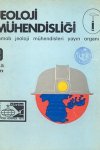
ABSTRACT: The area under investigation lies between Şabanözü and Eldivan towns of Çankırı where rock units ranging from Triassic to Quaternary crop out. The aim of this paper is present new data concerning the emplacement of the ophioEtic melange in this region,The metadetritic rocks of Kösrelik formaion (Lower Triassic) and the metavoleanics of the Yagizali formation show lateral gradaino and contain exotic blocks of Permian and Carboniaferous in age. These unite unsonformably overlain by the conglomerates and sandstones of Elmalı Formation (Anîsîan) which laterally passes in to Yeniçöte Formation of Ladmian-Oarnian age. The Yeniçöte formation is tectonically overlain by the Eldivan ophiolitic melanfe which contains gabbro, diabase, esrpantmiic, spilite, eherty limestone» radiolarite and mudstone. There are also limestone blocks of Liassic and Lower Cretaceous (Bemasian-VaJanginian-BaiTemian) age as well as the limestone blocks of unknow age in the ophiolitic melange. The Mart formation which is a typical flysch of Cenomanian- Turonian age unconformably overlies the ophiolitic melange starting with a conglomerate and passes vertically in to a limestone faciès of the same age (Kurşunludüz Fm,)* According to these d ata the Eldivan ophiolitic melange was emplaced to the region after Barremian and before Cenomanian-Turonîan time and possibly during the Austrian orogenic phase. The ophiolitic melanfe thrasted over the Miocene sediments during the foilowiftg tectonic events.
ABSTRACT: Plate tectonic models is far from anwering questions arising from emplacement of ophiolites. Theoretical and artifical differentiating and grouping of rocks causes further difficulties, A new point of view is essential for the ophiolite emplacement problem
ABSTRACT: Oil and natural gas or mine explorations are always needed well drilling. These wells can either be vertical of technology. In the following example I`ll try to introduce my studies in the or field Georgsdorf (figureS) of West Germany to obtain the possible best result, it Is recommended to follow the mentioned procedure, especially at geological profile passing through the indined weUs and some other geological studies which highly depends on these profiles. As it is seen some of wells drilled In the field have tadinationa. In the explanations, the procedure is given in general and simplified form for the Inclined wells. Inthelast part, the structural contour map of the oil bearing Bentheim sandstone level and tectonic structure are given The field is taken place in between the two major fault blocks and the information about the other wells in the region also used while drawing those two major faults,
ABSTRACT: The caJc-alkaline and alkaline volcanism which occurs over large areas in Western Anatolia» Thrace and the Aegean islands have kept its activity through out Tertiary and Quaternary periods* The results of petrologies! studies of these occurrences are given in the article and a possible concept of origin for these rocks is also suggested. Although the Cenozoic volcanism is discussed in this work, the Upper-Cretaceous volcanism the Black Sea coast is also mentioned brieflefly because of its relationship with the younger volcaMsm in the region understudy. The general purpose of this work is to quite a number of studies on volcanic rocks which show different pétrographie properties and extruded in different geolofical times* It is also intended m this work to point out the relationship amongst these different types of volcanic rocks as much as possible
ABSTRACT: This article presents an examination of the antimonite cinnabar^arsenopyriteseheellte deposits in the area surrounded by Kiraz-Halıköy-Baymdır-BoAdağ, It is shown that the antimonite exposed in the gneiss sequnee in the region of Çaylı-Tavşan Doruğu Tepe is a higher temperature formation as compared to the antimonite deposts which are devoid of berthlerite in the Overlying schists of Çayırlı-Hopuoğİu. On the other hand, the same host rocks show intergröwths of antimonite and arsenopyrite, pyrite, chalcopyrite and the low temperature conditions indicated by marcasite and cinnabar. The mercury deposits in the region occur along fractures and in cavities in the schists rather than in the hydrothermal quartz veins, Arsenopyrite deposits, like the antinïonite deposits which contain very small amounts of ranâomly distributed native gold grains of 40-50/u, are associated with the epigenetie hydrothermal veins of quartz in the schists and gneiss. The scheelite deposits occur along the Layering m the schiste as seen in Elmacı Gediği All tins deposits except scheelite are formed by hydrothermal mobUiiation m the sedimentary rock affected by the Variscan and Alpine Orogenies. It thtis suggests that these deposits are polygenetic m orifIn,
ABSTRACT: The objective of this study is the clastic sequence of Early Tertiary age, widely exposed to the south of Gemlik (Bursa). The sequence has been divided in to five distinct rock units, in ascending order: Segköy mudstone-eonglomerate unit, the Diirdane mudstone-sandstone unit, the Kurtul calcerouus mudstone unit, Hisartepe limestone unit and the Gençali mudstone-sandstone unit. The Seçköy unit is made lagely of volcanoclastic conglomerates. T^e Dürdan© unit consists of reddish, brownish mudstone, lithic sandstone and subordinate conglomérâtes. The Kurtul unit is made up of yellowish to whitish caicerous mudstone* The Hisartepe limestone is composed of white bioclastic limestone which includes abundant Early Eocene (Ypresien) fauna! elements. The Gengali unit consists of a thick interbedded succession of intercalating yellowish, greenish and reddish mudstones and thickly-bedded greenish sandstones The units are conformably stratified. The approximated total thickness of the studied elastic sequence is more than 630 m. The Sedimentologic and paléontologie characteristics of the units indicate a near-shore depositional environment.

 TMMOB
TMMOB